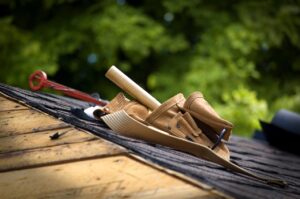A leaking roof can be a major headache for homeowners. Not only does it pose a threat to the structural integrity of your house, but it can also cause damage to your belongings and create an unhealthy living environment. If you are experiencing a leaky roof, it’s important to identify the root cause and address it as soon as possible. In this article, we will discuss the various reasons why your roof might be leaking and provide solutions on how to fix them. Whether you have a flat or pitched roof, understanding the potential causes of leaks can help you take appropriate action and prevent any further damage.
Age and Wear and Tear of Roof Shingles
A leaking roof often results from the age and deterioration of the shingles. Over time, exposure to harsh weather conditions can cause shingles to become loose or damaged, creating gaps where water can enter. This is especially true for asphalt shingles, which can deteriorate over time. To prevent leaks due to aging shingles, have them regularly inspected and replaced by specialists in residential roofing or a professional roofing company. Investing in high-quality shingles and proper installation can help extend the lifespan of your roof. ne correctly, even minor mistakes such as using incorrect materials or improper sealing can
Improper Installation or Maintenance
Improper installation or maintenance of your roof can also lead to leaks. If your roof is not installed properly, it may have weak spots where water can seep through. Neglecting routine maintenance and repairs can cause small issues to turn into major leaks over time. Hire a reputable and experienced roofing contractor for any installation or repair work on your roof. Regular inspections and addressing any issues promptly can prevent leaks and extend the lifespan of your roof. Properly maintaining your roof is essential in ensuring its durability and protecting your home from leaks.
Damaged Flashing or Caulking
Damaged flashing and caulking can also be a common cause of roof leaks. Flashing is the metal or plastic material installed around chimneys, vents, and other protrusions on your roof to prevent water from seeping in. Over time, flashing can become corroded or damaged, creating openings for water to enter. Similarly, caulking around these areas can deteriorate and allow water to penetrate your home. Regularly inspecting and maintaining flashing and caulking can help prevent leaks from occurring. If you notice any damage, have it repaired immediately by a professional.

Clogged Gutters and Downspouts
Clogged gutters and downspouts can also contribute to a leaking roof. When these water channels become filled with debris, they are unable to effectively drain water away from your roof. This can cause water to pool on your roof, leading to leaks and potential damage. Regularly cleaning and maintaining your gutters and downspouts is crucial in preventing this issue. You can do this yourself or hire a professional gutter cleaning service. Make sure that the downspouts are directing water at least 3 feet away from your home’s foundation to prevent any potential structural damage.
Extreme Weather Conditions
Extreme weather conditions such as heavy rain, strong winds, and hail can also cause your roof to leak. Over time, these elements can wear down your roof and create weak spots where water can enter. Regularly inspecting your roof after severe weather events and addressing any damage immediately can help prevent leaks in the future. Invest in high-quality roofing materials that are designed to withstand harsh weather conditions. Having a professional install your roof with proper techniques and materials can ensure its durability against extreme weather.
Structural Issues with the Roof Deck or Framing
In some cases, the root cause of a leaking roof may be due to structural issues with the roof deck or framing. Over time, these components can become weakened and compromised, creating openings for water to enter. This is especially common in areas with high humidity or where there is poor ventilation. If you suspect your roof deck or framing might be causing a leak, have a professional inspection conducted promptly. They will be able to identify any structural issues and provide solutions for repair or reinforcement to prevent further leaks. Regular maintenance and upkeep of these components can also help prolong the lifespan of your roof.
A leaking roof can result from aging shingles, improper installation, damaged flashing or caulking, clogged gutters, extreme weather, and structural issues. Regular inspections and timely repairs can prevent leaks and extend your roof’s lifespan. Using quality materials and hiring professionals for installation and repairs ensure durability. Maintain gutters, downspouts, flashing, and caulking to avoid leaks. These measures protect your home from water damage and ensure a safe living environment for your family.



